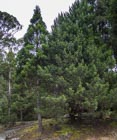
Athrotaxis selaginoides on left and Phyllocladus aspleniifolius on right; both are young mature trees in typical forest habitat. Waldheim Chateau, Cradle Mountain National Park, Tasmania [C. J. Earle, 2015.03.02].
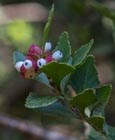
Mature female cones on a forest interior tree at Mount Field National Park, Tasmania [C. J. Earle, 2015.02.26].
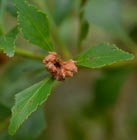
Foliage and cones; east of Cradle Mtn. National Park, Tasmania [©Rick Fencl, 2017.12.04].
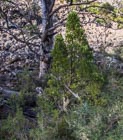
Sapling, growing in shade of Eucalyptus coccifera on vegetated talus near the upper limit of continuous forest. Mount Field National Park, Tasmania [C. J. Earle, 2015.02.26].
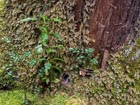
Seedlings of Phyllocladus aspleniifolius and Nothofagus cunninghamii growing at the base of an Athrotaxus cupressoides. Waldheim Chateau, Cradle Mountain National Park, Tasmania [C. J. Earle, 2015.03.02].
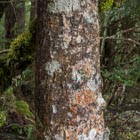
Bark on a tree about 25 cm DBH. The diverse lichen community is typical. Waldheim Chateau, Cradle Mountain National Park, Tasmania [C. J. Earle, 2015.03.02].

Typical shade foliage on a tree at the Royal Tasmanian Botanical Garden [C. J. Earle, 2015.03.08].
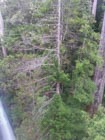
Canopy of a tree along the Tahune Airwalk. Note that crown has died back and is regrowing from epicormic sprouting along the defoliated stem, a rather unusual property that crops up occasionally in the Cupressaceae and Pinaceae as well [C. J. Earle, 2015.02.26].

Conservation Status

Phyllocladus aspleniifolius
(Labill.) Hook. f. 1845
Common names
Celery top pine, Adventure Bay pine.
Taxonomic notes
Synonymy (Farjon 1998):
- Podocarpus aspleniifolius Labill. 1806;
- Thalamia aspleniifolia (Labill.) Spreng. 1817;
- Brownetera aspleniifolia (Labill.) Tratt. 1825;
- Phyllocladus billardieri Rich. ex Mirb. 1825;
- Phyllocladus rhomboidalis Rich. et A. Rich. 1826;
- Phyllocladus trichomanoides D. Don var. glaucus (Carr.) Parl. 1868;
- Phyllocladus serratifolius Nois. ex Henkel et W. Hochst. 1865.
Description
Shrubs, or trees to 20 m tall and 50 cm DBH, typically with a single round bole. Branches spreading or ascending to form a pyramidal crown. Bark dark brown with large lenticels, with age becoming scaly and furrowed, with a red or pink inner bark. Twigs straight, round, stiff, smooth, the newest shoots reddish, maturing green. True leaves occur on seedlings and are 10-15 × 1 mm, linear, acute, with a midvein; stomata on the lower surface. Deciduous filiform leaves to 3 mm long appear on new shoots and on margins of phylloclades. Phylloclades are deciduous, mostly simple, flattened, 2.5-5 cm long, mostly cuneate or rhombic in outline, with crenate or lobed margins, with ± parallel venation; color varies from reddish at emergence through bright green, darkening with age. Stomata on the underside, numerous. Pollen cones on short stems branching from a terminal bud, in clusters of 1-5, 5-8 × 2-2.5 mm, pink, maturing yellow, soon deciduous. Seed cones axillary to filiform leaves, or terminal, in clusters of 1-4, each with 2-5 fertile bracts emerging from a red or purple structure 3-5 mm long. Seeds each in a white aril covering 2/3 of the seed, ca. 5 mm long, greenish black (Farjon 2010).
Distribution and Ecology
From sea level to timberline in the temperate rain forests of Tasmania at elevations of up to 1200 m. Climate is cool wet maritime with no seasonal drought. The largest and tallest trees occur at low elevations in Eucalyptus forest, typically as an understory tree (some of these eucalypts approach 100 m in height). Above 700-800 m elevation it occurs in woodland with subalpine species such as Eucalyptus coccifera, Nothofagus cunninghamii, N. gunnii, Athrotaxis cupressoides, A. selaginoides, and a rich diversity of shrubs. In alpine settings it occurs in acidic, well-drained soils (typically the parent material is dolerite) as a shrub with a highly diverse woody plant association that often includes the conifers Diselma archeri, Pherosphaera_hookeriana, and Podocarpus lawrencii (Farjon 2010 and pers. obs. 2015). You can create a highly detailed map, and access specimen data, using the "search" function at the Australia Virtual Herbarium.
Based on data from 53 collection localities, its climate preferences include a mean annual temperature of 9.0°C, with an average minimum in the coldest month of 1.7°C, and a mean annual precipitation of 1700 mm (Biffin et al. 2011, Table S5). Hardy to Zone 9 (cold hardiness limit between -6.6°C and -1.1°C) (Bannister and Neuner 2001).
A study of the lowland Eucalyptus regnans forest in the Styx Valley found that the stand originated following catastrophic wildfire ca. 1490-1510 A.D., with Eucalyptus and Phyllocladus both establishing in the initial regeneration cohort. Both species established widely in the initial cohort and have seen relatively little regeneration since that time; it follows that both have lifespans exceeding 500 years, and also that Phyllocladus, as well as Eucalyptus, is adapted to stand-replacing fire (Wood et al. 2010).
Remarkable Specimens
There are no data on particularly large or tall trees. The oldest recorded tree, 653 years, was a subfossil specimen dated from 1290 to 1942 and documented in a tree-ring chronology collected near Lake Pieman in western Tasmania, Australia by Val LaMarche (doi.org/10.25921/32j4-7y30). The same site produced the oldest living tree known, 579 years. Besides these, a ring count of 604 rings in 10 cm is reported from a tree on Mount Read, central Tasmania (IDS 1996).
Ethnobotany
Celery top pine has an attractive wood, is commercially harvested, and has been used for boatbuilding, woodturning, flooring, and cabinetry (Tasmanian Timber 2007).
This species presents a classic example of timber mining. The species is currently being exploited as a commercial crop and timber remains available. However, the trees take several centuries to mature. Such a course seems likely to lead to the commercial extinction of the species. Some conservation measures exist: "The conservation of the craftwood resource is related to the conservation of special species timbers as a whole. Large tracts of rainforest (34 per cent of the 565,000 ha total in the State) are reserved in Tasmania's National Parks and World Heritage areas. Of the 40 recognised rainforest plant communities, three are poorly reserved and three are not known in reserves" (Commonwealth of Australia 1999).
The species has research value due through dendrochronology. Twelve tree-ring chronologies were collected in about 1971 by the Americans Valmore C. LaMarche Jr. and Peter W. Dunwiddie in what were evidently the first explorations of the dendrochronological characteristics of the species (NOAA, Ogden and Dunwiddie 1982). Shortly thereafter, the Australians and New Zealanders began work in the area, assembling chronologies for a variety of native gymnosperms and successfully applying them to a variety of problems in work summarized by D.A. Norton, John Ogden and J.G. Palmer (Palmer and Ogden 1992, Norton and Palmer 1992, Ogden and Dunwiddie 1982). P. aspleniifolius has not been employed as extensively as some other Australasian species, but has been useful in some studies of past climate variation and in estimation of variations in atmospheric carbon-14 production in the southern hemisphere (Barbetti et al. 1995). The earliest tree-ring chronology based on live trees begins in 1450 AD.
Observations
This species is quite common within its range in Tasmania. I found it at the Tahune Airwalk, Mount Field National Park, and Lake St. Clair National Park, and Cradle Mountain National Park.
Remarks
The epithet compares this species to the foliage of a maidenhair fern, specifically, Asplenium ruta-muraria, a European species (Farjon 2010).
Citations
Commonwealth of Australia. 1999. Tasmania. http://www.rfa.gov.au/rfa/tas/raa/soceco/ch6_4.html, accessed 2000.04.24, now defunct.
International Dendrology Society. Year Book 1996.
NOAA. The NOAA Paleoclimatology Program Tree-Ring Data Search Page.
Tasmanian Timber. 2007. Celery Top. http://www.tastimber.tas.gov.au/species/pdfs/Celery.pdf, accessed 2017.12.29.
Wood, S. W., Q. Hua, K. J. Allen, and D. M. J. S. Bowman. 2010. Age and growth of a fire prone Tasmanian temperate old-growth forest stand dominated by Eucalyptus regnans, the world’s tallest angiosperm. Forest Ecology and Management 260:438-447.
See also
Allen, K. J. 2002. The temperature response in the ring widths of Phyllocladus aspleniifolius (celery–top pine) along an altitudinal gradient in the Warra LTER Area, Tasmania. Geographical Research 40(3):287-299.
Allen, K.J. 1998. A dendroclimatological investigation of Phyllocladus aspleniifolius (Labill.) Hook.f. Ph.D. dissertation, The University of Tasmania. 344 pp.
Barbetti, M., T. Bird, G. Dolezal, G. Taylor, R. Francey, E. Cook, and M. Peterson. 1992. Radiocarbon variations from Tasmanian conifers: first results from late Pleistocene and Holocene logs. Radiocarbon 34(3): 806-817.
Barker, P.C.J. 1995. Phyllocladus aspleniifolius: Phenology, germination, and seedling survival. New Zealand Journal of Botany.
Barker, P.C.J. and J.B. Kirkpatrick. 1994. Phyllocladus aspleniifolius: variability in the population structure, the regeneration niche and dispersion patterns in Tasmanian forests. Australian Journal of Botany 42(2):163-190.








